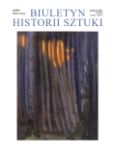Jan Chrystian Kamsetzer – architekt królewski. Przyczynek do badań nad genezą twórczości
Jan Chrystian Kamsetzer: King's Architect. Contribution to the Research into the Genesis of His Output
Author(s): Marzena Królikowska-DziubeckaSubject(s): Architecture, Visual Arts, 18th Century, History of Art
Published by: Instytut Sztuki Polskiej Akademii Nauk
Keywords: Jan Christian Kamsetzer; 18th century architecture; King Stanisław August; Marcello Bacciarelli;
Summary/Abstract: The profile of the Saxon architect Jan (Johann) Chrystian (Christian) Kam(m)setzer is presented in the light of a new source investigation, mainly based on of his correspondence with the Royal Court in Warsaw. The future architect was born in Dresden on 14 January 1753 in the Kreuzkirche Evangelical parish to a family of bakers (as testified to by archival research in Dresden). He was educated at the Dresden Academy of Fine Arts, under e.g. Friedrich Krubsacius (1718-90). Aged twenty, he arrived in Warsaw, possibly as recommended by Marcello Bacciarelli, and served the King for twenty years as of 1773. Initially, he cooperated with the architect Jakub Fontana, and following his death, with Domenico Merlini, the First Architect at the Court. Kamsetzer contributed to the extensions of the royal residences: of the summer Royal Łazienki Palace (e.g. in 1788, he independently designed the northern façade) and of the Royal Castle. Furthermore, he designed some interiors of the Royal Łazienki, e.g. the Ballroom or the Theatre on the Island, the latter raised in 1790-93. Its antiquitizing form echoes the auditorium in Pompeii and Herculaneum which the architect had had an opportunity to study personally on his trip. Apart from the works for King Stanislaus Augustus, Kamsetzer also authored palaces and churches in other localities throughout Poland. His activity and the attempt to analyse the genesis of his output may contribute to a wider investigation into the issues of architecture under King Stanislaus Augustus. Apart from the architect’s studies, one of the major factors shaping his designs were two trips the architect went on. In 1776-7, he travelled to Istanbul as an official draughtsman of the Polish diplomatic mission; on that trip it was also possible to visit the western coast of Asia Minor, the Cyclades, Greece, but first and foremost Athens. Moreover, of exceptional importance was his second artistic trip across Europe in 1780-82. On that occasion, Kamsetzer visited Austria (Vienna), as well as numerous Italian destinations (Venice, Vicenza, Rome, Naples, Sicily), then he reached France, England, Holland, and German countries. It was a unique experience in his life, accompanied by numerous drawings he executed along the way. They testified to studies he conducted illustrating his interest in selected buildings as a factor of a definite aesthetical attitude. Another source reflecting the process of the shaping of Kamsetzer’s architectural tastes were the letters sent directly to Marcello Bacciarelli, to be later relayed to King Stanislaus Augustus Poniatowski. The King financed both voyages of the architect and allocated definite allowances for the purpose; the allowance for the second trip amounted to 250 ducats, with the architect’s additional stipend of initially 20 and later 24 ducats monthly. It was the court painter Marcello Bacciarelli who was of major importance for the whole voyage project; he was the one to supervise the trips, frequently intervening with the Warsaw court on financial issues. There developed a strong personal bond between the two men This also testified to by the fact that the architect stayed with Bacciarelli’s family in Rome for eighteen months. Furthermore, the correspondence reveals close relations the architect had with other members of the painter’s family: his mother Ortensia Salvati, his brother Canon Serafin, his sister Vincenza, and other siblings...
Journal: Biuletyn Historii Sztuki
- Issue Year: 81/2019
- Issue No: 4
- Page Range: 583-599
- Page Count: 17
- Language: Polish

